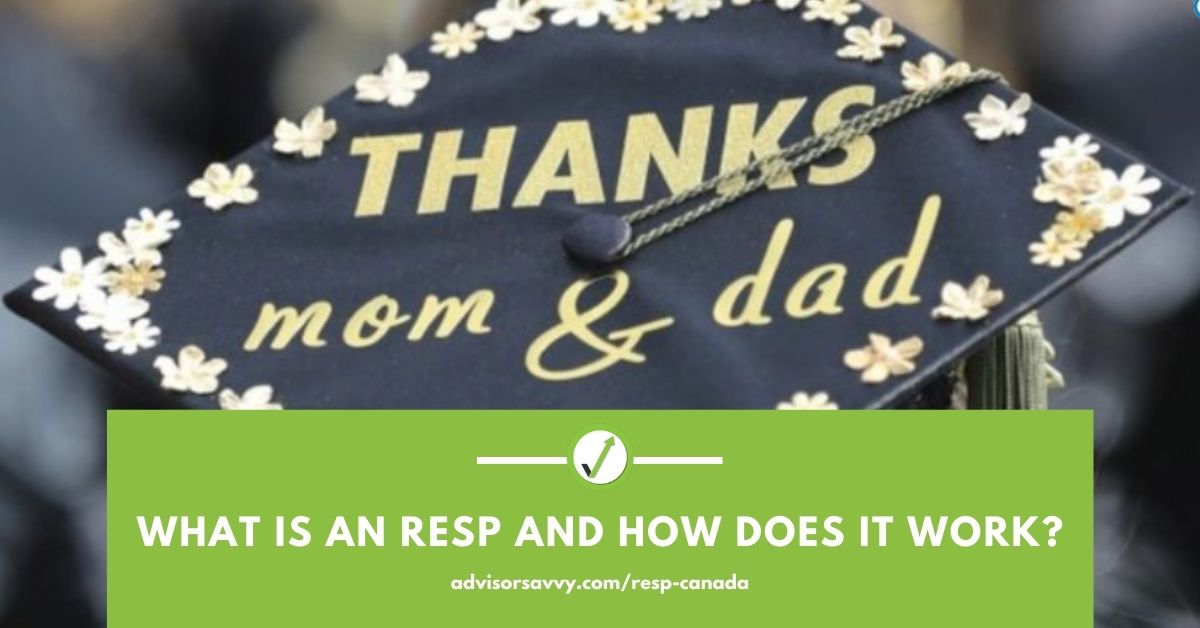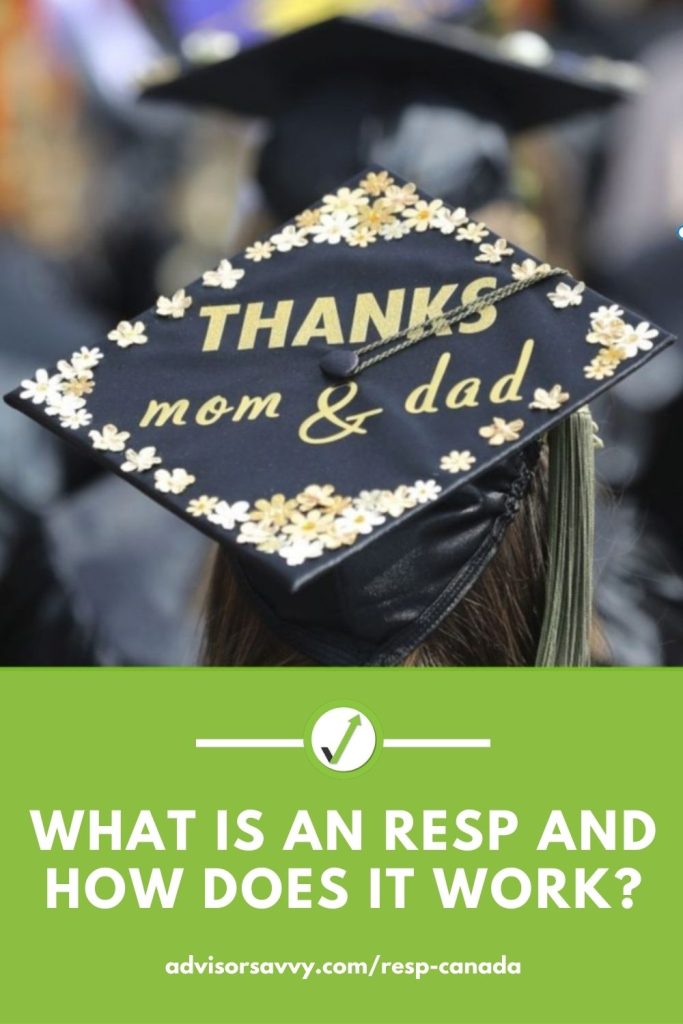
Funding post-secondary education in Canada is becoming more and more costly. Long gone are the days when working a summer job paid for a year of school. If higher education is in your future, ideally you or your family invest in an RESP — and have been for a while.
With the increasing cost of higher education, many new parents today open an education savings account as soon as their children are born.
Making sure your children can afford to pursue post-secondary education requires forethought, planning and investing.

Table of contents
- What is an RESP?
- How does an RESP work?
- What are the benefits of an RESP?
- Is there an RESP limit?
- What is the advantage of RESPs?
- How does a Family RESP work?
- Three reasons to open an RESP
- How to open an RESP
- What if my child doesn’t go to university or college?
- Can I withdraw money from an RESP early?
- How much will be in the RESP when the time comes to use it?
- What with leftover funds in an RESP?
What is an RESP?
A Registered Education Savings Plan (RESP) is an investment vehicle that new parents or guardians of children use to save for post-secondary education. The funds grow as the child grows so that after graduating high school, there is significant money set aside for post-secondary education.
The money in an RESP is specifically for the purpose of funding school for the beneficiary.
FYI: Help your kids get a solid foundation in all things money-related. Be sure to read our article on when to teach kids about money!
How does an RESP work?
Unlike other savings tools, the RESP has one use — paying the costs associated with attending higher education. To qualify, the beneficiary must attend a university, college or other educational institution in Canada as per the Canada Student Financial Assistance Act. Because of that, there are specific RESP withdrawal rules (see below)
RESP funds cover school-related expenses, including tuition, books and transportation.
Are RESP contributions tax deductible?
Simply put, they are not — unlike an RRSP that reduces your taxable income. Your RESP investment will grow tax-free, but it isn’t taxed until the money is taken out when your child is preparing to head to college or university.
How do I report an RESP on my tax return?
Your RESP carrier will send the beneficiary (i.e. the student) a T4A slip before tax time.
Related Reading: Estate Planning Checklist for Canadians
What are the benefits of an RESP?
Unlike investing in an RRSP, which reduces your taxable income, there is no tax advantage to investing in an RESP. However, there are other benefits of an RESP that the RRSP does not enjoy. And perhaps the biggest benefit is the Canada Education Savings Grant.
What is the Canada Education Savings Grant?
The Canada Education Savings Grant (CESG) is a government bonus that contributes to your RESP. With the CESG, the government matches 20% of your contributions to an RESP, up to $500 per beneficiary per year. So as long as you contribute the maximum $2,500 annually to an RESP until your child’s 18th birthday, the government contributes a maximum of $7,200.
Other benefits
The CESG is one big benefit of investing in an RESP. In addition, like other types of investments, you can invest an RESP account in stocks, ETFs and other money market options. This helps your investment grow. And, because the investments are in the RESP, they are sheltered from tax for as long as the money is in the account.
Related Reading: Canada Deposit Insurance Corporation
Is there an RESP limit?
There is no personal contribution limit for an RESP. However, there is a limit to government contributions to that investment. Therefore, since there is no personal tax benefit — and if you already receive the maximum CESG benefit — consider an RRSP for additional savings.
What is the advantage of RESPs?
You won’t see a benefit at tax time for an RESP contribution. But, let’s be honest, it’s not often the government gives you money. So, take advantage of this unique opportunity. Let the government help pay for your child’s education by investing in an RESP. You save towards your child’s schooling and see contribution matching of $500 a year. In addition, you enjoy the interest and dividends on those contributions. All the while, you save money, tax-free, until it’s time to withdraw.
How does a Family RESP work?
With a family RESP, you name multiple beneficiaries under one RESP. If you have multiple children, there is some value to contributing to a family RESP rather than an individual fund. But, it’s not necessary.
Each individual beneficiary still benefits from the CESG, even as part of the family RESP. One benefit is the simplicity of having only one RESP to manage. Another benefit is allotting the funds. For example, what if one child’s program requires more funding than another? By having all of the funds in one place, the sibling with the higher education costs benefits from the growth and RESP contributions to the family RESP over its lifetime.
Related Reading: Types of Investment Accounts in Canada
Three reasons to open an RESP
Beyond government grants and tax savings, there are other reasons to invest in an RESP.
Extended family and friends can contribute
Anyone can set up and contribute to an individual RESP for your child. And that means friends and family can help fund your child’s education. These additional funds also help get the maximum benefit from the government. This is a handy piece of information.
If you don’t think your child needs the latest trend for the holidays or their birthday, suggest a gift of an RESP contribution. Friends and family like easy gift ideas. Meanwhile, your child gets money for their future educational needs. And you help them work towards getting the max CESG. It’s a win-win-win situation.
The beneficiary pays the RRSP withdrawal tax
You make the contributions. But the good news is you don’t take the tax hit when withdrawing the money. Beneficiaries withdraw funds in the form of educational assistance payments (EAPs). Tax is applied on the EAP withdrawal as income for the beneficiary. Don’t worry about burdening your children with this tax hit. Because their income is significantly lower than yours, if not completely non-existent, their tax hit is minimal at best.
Also, remember that full-time students get their own tax breaks. And this helps reduce, if not entirely offset, the income tax hit on the EAPs.
They stay open for a long time
An RESP remains active for 36 years. So, if the intended beneficiary is unsure about their future path, the money isn’t lost. As long as they attend post-secondary at some point before the account expires, they benefit from the contributions, interest and CESG in the account. A gap year — or 10 — doesn’t void the RESP.
Related Reading: Balance Transfer Credit Cards Canada
How to open an RESP
Like any registered account, discuss your investment options with a financial services professional, such as a financial advisor or a bank employee. They can get the ball rolling on saving for your child’s post-secondary education, including setting up RESP payments. Opening an RESP requires your child’s social insurance card and your child’s birth certificate, or permanent resident card.
What if my child doesn’t go to university or college?
There are a few options available to you if your child decides not to go to school.
Wait it out
As mentioned earlier, you have 36 years to use that money. So don’t worry if your child decides not to go. Just leave it there and wait. They may just change their mind.
Transfer it to a sibling
Under the RESP rules, the money is used by the beneficiary or a sibling of the beneficiary. Transferring it is always an option. But remember – that $7,200 maximum contribution from the government is per beneficiary. If the child who is not attending school received some or all of that $7,200 as did the sibling, that money has to go back to the government.
The good news is that the interest earned from having it accrue all those years remains in the account and can be transferred.
What if there is no sibling to transfer the money to? Then, the entirety of the CESG returns to the government. And there are options for managing the unused funds in the account.
Transfer it to an RRSP
If the money isn’t used for post-secondary purposes, it returns to you to use as you choose. If you withdraw it in full, it is taxed at your tax rate. In addition, there is a penalty. Alternatively, if you have enough room in your RRSP, transfer it directly into one to avoid any tax implications.
Can I withdraw money from an RESP early?
The money in the RESP is meant to stay there until the beneficiary withdraws it to put towards their post-secondary education. Withdrawals for any other reason mean a hefty fine. For one, it adds to your taxable income, dinging you at tax time. Secondly, you pay the government a 20% penalty on withdrawals unless you transfer it to an RRSP (if you have the contribution room).
Can I withdraw from an RESP for non-educational purposes?
Yes. But there are consequences. Aside from the tax hit and the penalty, you return any government-contributed funds in the RESP, in full.
For example, if you want to buy a house and see the RESP nest egg as a possible source of funding, think twice. Your wallet gets hit hard during tax time. And really, expenses like down payments are what RRSPs are for.
How much will be in the RESP when the time comes to use it?
Get a solid idea of what your RESP contributions and CESG look like years down the line by plugging some numbers into an RESP calculator. The RESP calculator shows you how your contribution, the potential investment potential, and the CESG work together to grow your investment.
An RESP is a powerful savings tool that helps prepare the people you love for the dream of higher education. So, maximize your contributions. Then, your beneficiary enjoys the added bonus of government contributions they otherwise may not receive. Want to know how to get the most out of your RESP? Speak to a financial advisor.
What with leftover funds in an RESP?
What if your child decides not to pursue higher education, or doesn’t use all of the funds in the RESP account? Well, there are a few options for unused or leftover RESP funds.
Consider transferring the funds to a sibling of the child. Or, transfer the funds into an RRSP to avoid tax implications. Alternatively, leave the funds in the account on the chance the beneficiary decides later in life to pursue higher education. Just because they aren’t in school now doesn’t mean they won’t go in the future.
Thankfully, the government provides enough options that the good work you do to save for your child’s future does not go to waste.
Read More: How to Withdraw Money from RRSP
